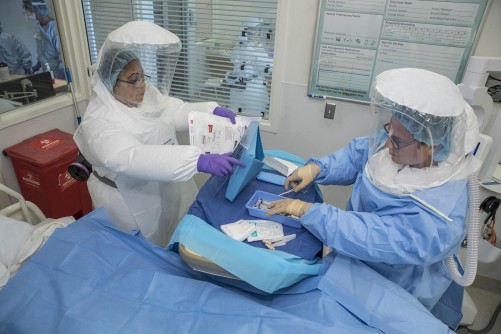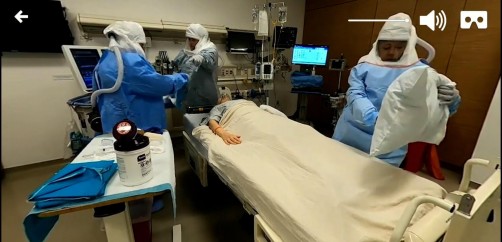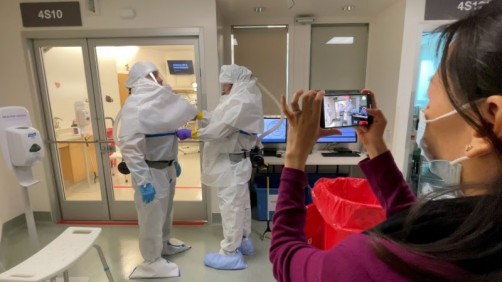Cedars-Sinai's Special Forces of Infection Control. Courtesy of Cedars-Sinai.
When the COVID-19 pandemic hit, healthcare professionals around the globe had to quickly learn to stay safe while treating patients diagnosed with a highly contagious virus. At Cedars-Sinai, staff members had a secret weapon: the Special Pathogens Response Team.
The team is a unit of approximately 80 hospital employees who have been specially trained to treat patients with the Ebola virus, one of the most infectious and deadly diseases on the planet. After the 2014 Ebola outbreak in West Africa, Special Pathogens Response Team members learned how to carefully use personal protective equipment (PPE), and how to handle infectious waste and perform challenging procedures such as inserting a breathing tube in a patient while wearing so much gear.
When COVID-19 emerged, the team was ready to share with their colleagues what they had learned about providing care in the presence of a highly-contagious virus.
"These nurses, physicians, respiratory therapists, lab scientists and environmental services workers already are experts in their everyday jobs," said Jennifer Garland, PhD, RN-BC, Special Pathogens Program manager. "We train them in infection control so they can provide the same high level of care that they would if a patient didn't have a deadly, contagious disease."

Phaedra Harris, RN, and Oren Friedman, MD, prepare to do a procedure during a Special Pathogens Response Team Ebola drill in 2017. Photo by Cedars-Sinai.
Special Forces of Infection Control
The team helps Cedars-Sinai serve as one of 10 federally funded Regional Ebola Treatment Centers, a network of specially prepared hospitals created after the deadly outbreak in West Africa.
During the COVID-19 pandemic, the Special Pathogens team has trained thousands of healthcare workers across Cedars-Sinai how to carefully put on and take off PPE and do their jobs without spreading the coronavirus.
"They're like the special forces of infection control," said Garland, who treated Ebola patients in Sierra Leone during 2015. Without electricity or running water, she had to manage with what she had, which often was low-tech: a bottle of Coca-Cola to comfort a patient.
"We couldn't do everything we wanted for them, and many patients passed away," Garland recalled. "It was very difficult to watch."
At Cedars-Sinai Medical Center, Garland applies that experience to training a team that has a wide array of sophisticated tools.
Physicians and nurses in full protective suits can practice drawing blood from a lifelike mannequin in a mock hospital room in the Women's Guild Simulation Center for Advanced Clinical Skills. Invisible powder sprinkled on the mannequin mimics the spread of germs. After a training exercise, team members run their bare hands under a UV light that can illuminate powder traces, revealing whether someone could have become contaminated with viral particles.
"The simulation center is an awesome place to practice. It makes everything seem real," said longtime team member Phaedra Harris, RN, a critical care nurse. "The room is set up like an actual intensive care unit, so you're aware of your surroundings while training in the PPE."
Harris and the team have held full-scale drills with federal and local agencies, accepting fake patients driven to the medical center in an ambulance rigged with protective barriers. They've practiced drawing blood and running tests on specimens in an intensive care unit suite equipped with a patient room, lab and safe zone for putting on and taking off protective gear.
"After my first drill, I was hooked, and I've loved it ever since," Harris said. "The work is so intense and detailed and different from anything else I've ever done."

In a 360-degree training video, Special Pathogens Response Team members prepare to place a breathing tube in a mannequin. Photo by Cedars-Sinai.
Ready for the Next Big Threat
Harris said her special pathogens training helped her feel more confident when the novel coronavirus started spreading in the U.S. last year and so much remained unknown.
"I felt like the expert on the floor for donning and doffing (putting on and taking off PPE), and I could help other staff members who visited our unit," she said.
When the pandemic forced Harris and her fellow team members to stop training in large groups, they created 360-degree videos that staff members could view with virtual reality goggles. Watching these immersive videos, staff members can experience standing at a patient's bedside and watching as team members place a breathing tube, collect a blood sample, mop up an infectious spill and dispose of dangerous waste.
The team continues to practice treating patients with Ebola, which is making headlines again amid an ongoing outbreak in Guinea. But they've also been focusing on infectious respiratory illnesses and other coronaviruses such as Middle East Respiratory Syndrome.
"There's an average of about five new diseases that are discovered every few years," Garland said. "Just because we're moving in the right direction with a global pandemic, doesn't mean we're finished."
Source: Cedars-Sinai

Be the first to comment on "How Cedars-Sinai Prepared for Pandemic Patients"